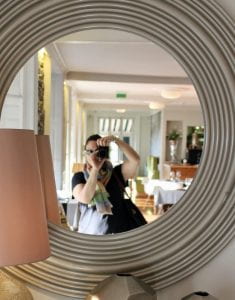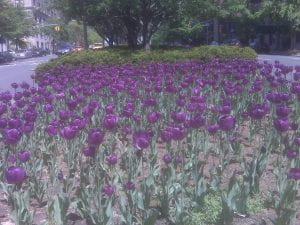“We travel not to escape life, but for life not to escape us.”
~ Unknown

In thinking about a photo that represents my personal landscape and carries my history, I started to think about the places that I have lived (a handful of cities and states throughout the US and two cities, in two different provinces in Canada). While important to shaping who I am to this day, none felt entirely representative of my history. This led me to think about the places I have traveled to. I have been on many beach vacations, but is that the landscape that best represents me? I treasure my visits to Whistler, BC, Canada, and yet don’t partake in winter sports or particularly enjoy the cold or the snow. Then it clicked; I don’t have a specific landscape that represents me, as my landscape is always changing, which perfectly represents my history, and how I crave the many different people, places, and experiences that life has to offer.
In reference to the bedrock of democracy, Williams shares “Each of us belongs to a particular landscape, one that informs us who we are, a place that carries our history, our dreams, holds us to a moral line of behavior that transcends thought” (Williams 19). My ever-changing place and my desire to see and learn about new people, places, and cultures helps shape and point my own moral compass. My resonance with this nomadic craving allows me the opportunity to place myself in an unfamiliar landscape and do my best to absorb the culture around me. In turn, I am always awed by how connected all humans are, regardless of where we are in the geographic world. In my varied landscape, I am able to carry both my past and create my dreams.

I chose the photo of me taking a photo to represent the many layers that are embedded in what we “see”. The picture of myself in the mirror captures me, yet also is a reflection of me. My landscape of the places I have been to and those I have yet to discover, help me see my true self as well as the authenticity of others when our paths intertwine. The most amazing thing about the changing landscape is that we are afforded the opportunity to see ourselves in a new place and yet through the experience, have a reflection of ourselves in this new landscape.

I agree with Barbara Kingsolver and her fundamental view on the importance of nature. However, the nature that she writes about is vast and quiet, and she seems to think that is advantageous over the limited interactions city dwellers have with nature. As someone who has lived in large cities, I think that the small glimpses of nature that exist in cities actually have more of an impact as they are so rare and coveted. Springtime in New York City was always one of my favorite times; it is an example of how effortless growth and abundance are in nature. Nature doesn’t compete against itself, each flower and tree bloom in their own time. In a city surrounded by concrete, noise, cars, and people, seeing a patch of flowers that quietly and beautifully bloom each Spring make even the busiest of city dwellers stop to take it all in.
A similar concept was presented in The New Sisterhood of Black Female Homesteaders in that the women interviewed for the story found a connection to nature, regardless of the setting they were in. One woman found that in her quest to garden in her yard, her city thought her wood chips were causing harm to the surrounding environment. Another woman shared that in her connection to nature and gardening, she learned to be patient. Nature has its own timeframe, one that doesn’t always work with her schedule. When she doesn’t feel well, she has learned to lean on her community to help her. These women found beauty and healing in nature. It didn’t matter that they had small plots of land in their suburban yards, nature in any sized dose helped enforce how necessary connection to it is.
Place is important as a concept, and may not always be represented as a stationary place on a map. Our landscape, be it external or internal, helps inform us of where we have been, and where we want to go. The landscape that we feel most connected to helps anchor us and reminds us what a special role nature – be it the unspoiled beauty of Mother Earth or cityscapes that humans have created – plays in that picture.
Kingsolver, Barbara. Knowing Our Place.
“The New Sisterhood of Black Female Homesteaders.” Pocket, getpocket.com/explore/item/the-new-sisterhood-of-black-female-homesteaders?utm_source=pocket-newtab.
Williams, Terry Tempest. Red: Passion and Patience in the Desert. Vintage, 2002.

Hi Christine! I loved reading your perspective on nature in the cities. I truly did not think about it that way and I found your answer very thought provoking. When you said that nature does not compete with itself and every tree and flower has its own time, I loved this because it is a perfect example of how human can directly relate to nature. In my first blog reply I touched on the comparison game that we can play with ourselves especially living in the age of social media (that is ultimately why I chose to get off of social media – except tik tok, and I only use that to find new recipes), and in this age of social media we can far too easily forget that we, like the earth, are very diverse and each have different talents and strengths and will each have our individual time. Much like we see mums in the fall and tulips in the spring.
Also, expanding on human diversity, I love how you talked about your landscape and history being a culmination of all the places you have traveled. I think that this speaks to the beauty of human diversity that we all do not have to identify with one place or landscape – and I believe that maybe why we don’t is because, through empathy, understanding and education of our diversity we are being molded into the human race and not somewhere that separates everyone. I also think your answer is complimentary to the definition of ecofeminism – that there is not just one black and white definition, just like you do not have a set personal landscape.
Hi Christine,
Thank you for your wonderful post. I appreciated your thoughtfulness in what a sense of place means to you as someone who has moved around a lot. You wrote about how your personal landscape is always changing, and in many ways that reflects changes we see in the natural ecosystem.
For example, there is a very famous beach in Japan called “Shirahama Beach.” Shirahama means “white,” and the original beach there was white. However, beaches naturally move due to waves, currents, typhoons and other environmental forces. The town of Shirahama did not want to lose its beach, so it started importing white sand from other places such as Perth (Australia). This is a common step taken in tourist areas that are dependent on beaches such as Hawaii. The more natural action would have been to allow the beach area to drastically change and perhaps be lost. Ironically the unnatural action of importing sand to a beach was to maintain the “natural” area. I think it can be difficult for people to accept change is not something inherently natural or unnatural.
Thinking of change, landscape and all of the articles this week have made me think about what we consider to be the natural world (forest, farm, park, beach, imported sand..?). You wrote about the small but importance glimpse of nature that a city dweller can experience. I would be curious what people in this class have as a definition of nature.
Shirahama beach: Shirahama time (kansaiscene.com)